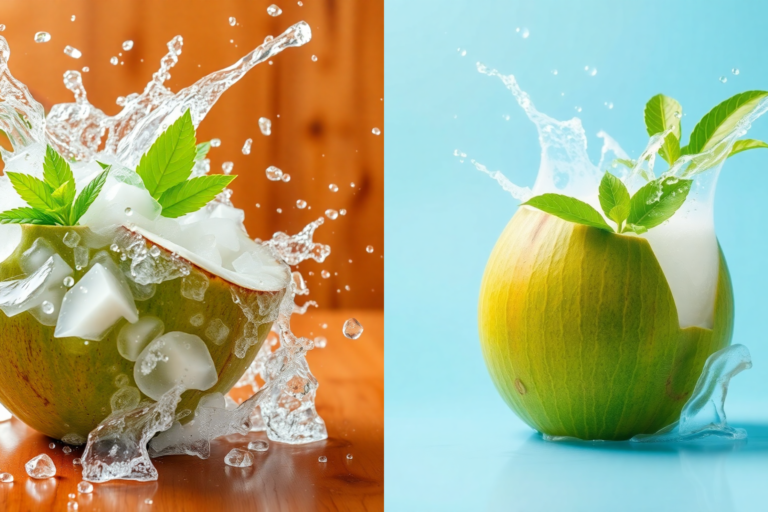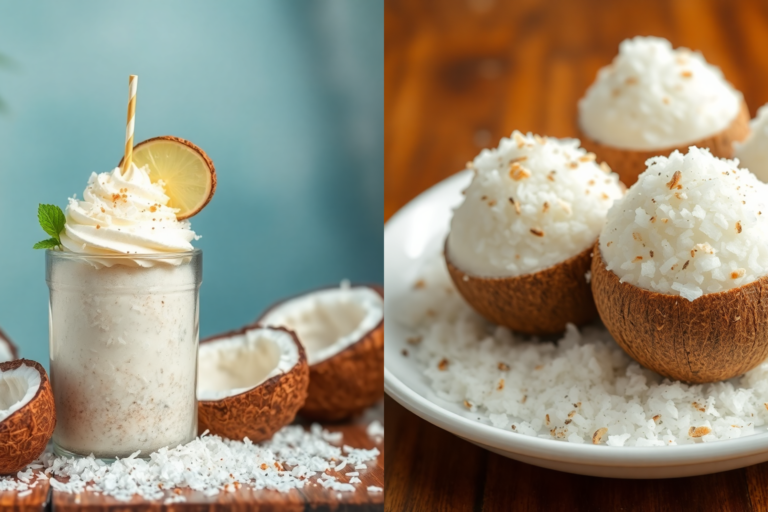Introduction: Discovering Desiccated Coconut
Desiccated coconut is a popular ingredient made by shredding and drying the meat of mature coconuts. Known for its rich flavor and chewy texture, desiccated coconut is commonly used in a variety of sweet dishes, from coconut macaroons to tropical fruit cakes. Its natural sweetness and subtle nuttiness make it an ideal addition to desserts, providing both taste and nutritional benefits.
However, the versatility of desiccated coconut extends beyond sweet treats. This delightful ingredient can enhance savory dishes as well, adding a unique texture and flavor profile. Whether incorporated into curries, sprinkled over salads, or blended into smoothies, desiccated coconut can elevate the culinary experience in countless ways. Its ability to complement a wide range of flavors makes it a staple in many kitchens, allowing home cooks and professional chefs alike to explore its potential.
As we delve deeper into the benefits of desiccated coconut, you’ll discover how this nutrient-rich ingredient can be easily incorporated into your diet, enhancing both the taste and healthfulness of your meals.
Use 1: Coating for Proteins with Desiccated Coconut
Description:
Desiccated coconut is an excellent choice for creating a crunchy coating for various proteins, including chicken, fish, or tofu. This simple yet effective technique enhances the texture and flavor of your dishes, transforming ordinary proteins into delightful meals.
To use desiccated coconut as a coating, start by preparing your protein of choice. Cut chicken breasts, fish fillets, or tofu into bite-sized pieces. In one bowl, whisk together eggs or a plant-based alternative to create a binding agent. In another bowl, combine desiccated coconut with seasonings such as salt, pepper, garlic powder, or even a pinch of cayenne for added heat.
Dip the protein pieces into the egg mixture, ensuring they’re fully coated. Then, roll them in the desiccated coconut mixture, pressing gently to adhere. Place the coated pieces on a baking sheet or in a hot skillet. Bake or pan-fry until golden brown and crispy. The result is a crunchy, flavorful crust that complements the inherent taste of the protein.
Benefit:
Using desiccated coconut as a coating not only adds a satisfying crunch to your proteins but also imparts a subtle coconut flavor that elevates the overall dish. The combination of textures—the crispy exterior from the desiccated coconut and the tender interior of the protein—creates a delightful eating experience. This method is particularly appealing for those looking to incorporate more flavor and diversity into their meals while enjoying the health benefits of desiccated coconut.
Use 2: Incorporated in Curries
Description
Desiccated coconut is a fantastic addition to curries, bringing a unique creaminess and depth of flavor that enhances any dish. When you incorporate desiccated coconut into your curry recipes, it not only thickens the sauce but also imparts a rich, tropical taste that complements the spices beautifully.
Adding desiccated coconut is simple; just stir it in during the cooking process, allowing it to rehydrate and blend seamlessly with the other ingredients. This versatility makes desiccated coconut a go-to ingredient for both traditional and modern curry recipes.
Benefit
The inclusion of desiccated coconut in curries provides multiple benefits. First and foremost, it thickens the sauce, creating a luscious texture that coats your ingredients perfectly. This thickening property helps to create a more satisfying mouthfeel, turning a simple curry into a hearty, comforting meal.
Moreover, the rich, tropical flavor of desiccated coconut enhances the overall taste profile of the dish. It balances out the heat from spices and adds a hint of natural sweetness, making your curries more complex and enjoyable. Whether you’re making a coconut curry, a spicy vegetable medley, or a fragrant chicken curry, desiccated coconut elevates the dish to new heights.
Incorporating desiccated coconut into your curries not only boosts flavor but also contributes nutritional benefits. It is rich in dietary fiber, healthy fats, and essential minerals, making your meal both delicious and nutritious.
Use 3: Desiccated Coconut in Savory Rice Dishes
Description
One of the most delightful uses of desiccated coconut is in savory rice dishes. By stirring desiccated coconut into rice preparations like pilaf or fried rice, you can elevate the flavor profile and texture of the meal. The subtle sweetness and nutty notes of desiccated coconut harmonize beautifully with a variety of spices and vegetables, creating a unique culinary experience.
In a classic pilaf, for instance, adding desiccated coconut introduces an exotic twist. As the rice cooks, the coconut rehydrates slightly, infusing each grain with its rich flavor. You can enhance the dish further by incorporating ingredients like sautéed onions, garlic, and your favorite vegetables, along with aromatic spices such as cumin, cardamom, and turmeric.
When it comes to fried rice, mixing in desiccated coconut not only enriches the dish but also adds a delightful crunch. As you toss the rice with soy sauce and assorted vegetables, the desiccated coconut provides a nutty texture that complements the overall dish. This combination makes for a satisfying meal that’s both nutritious and full of flavor.
Benefit
The inclusion of desiccated coconut in savory rice dishes offers several benefits. Firstly, it adds a unique flavor that transforms ordinary rice into a standout dish. The nutty texture from the desiccated coconut also enhances the overall mouthfeel, making each bite more enjoyable.
Moreover, using desiccated coconut is an excellent way to incorporate healthy fats and dietary fiber into your meal. This not only contributes to your daily nutrient intake but also supports digestive health and provides a sustained energy release. The healthy fats found in desiccated coconut can help keep you feeling full longer, making it a perfect addition for those looking to maintain a balanced diet.
In conclusion, the versatility of desiccated coconut in savory rice dishes allows for creativity in the kitchen while offering health benefits that enhance your overall meal experience. So next time you’re preparing rice, consider adding desiccated coconut for a delicious and nutritious twist!
Use 4: Desiccated Coconut as a Garnish for Soups
Description
Desiccated coconut is an excellent choice for garnishing soups, especially those featuring a coconut base or tropical flavors. Its fine texture and subtle sweetness complement a variety of soups, enhancing both taste and presentation. When sprinkled atop a bowl of creamy coconut curry soup or a vibrant tropical vegetable broth, desiccated coconut adds a unique visual element, making the dish more inviting.
Benefit
Using desiccated coconut as a garnish provides a delightful crunch that contrasts beautifully with the smoothness of the soup. This texture not only enhances the sensory experience but also elevates the overall appeal of the dish. The white, flaky appearance of desiccated coconut creates a striking visual contrast against rich, colorful soups, making them look more enticing.
In addition to its aesthetic benefits, desiccated coconut contributes valuable nutrients. It’s rich in dietary fiber, which aids in digestion, and it contains healthy fats that provide energy. This means that garnishing your soups with desiccated coconut not only improves their look and texture but also boosts their nutritional profile.
How to Use
To use desiccated coconut as a garnish, simply toast it lightly in a dry skillet until it’s golden brown. This step enhances its flavor and aroma, adding depth to your soups. Once toasted, sprinkle it generously over the soup just before serving. This ensures that the desiccated coconut retains its crunch and doesn’t become soggy.
Use 5: In Baked Goods and Bread with Desiccated Coconut
Description
Incorporating desiccated coconut into baked goods and bread is a fantastic way to enhance flavor and texture. This versatile ingredient can be added to various recipes, including savory bread and flatbreads, bringing a delightful twist to traditional baking. When used in bread recipes, desiccated coconut provides not only a unique taste but also a lovely moisture that can elevate the overall quality of the bread.
How to Use Desiccated Coconut in Baked Goods
To incorporate desiccated coconut into your bread, you can mix it directly into the dough or batter. For savory breads, consider pairing it with ingredients like cheese, herbs, or spices. The desiccated coconut will add a subtle sweetness that balances out savory flavors. You can also sprinkle some on top before baking for an appealing texture and a beautiful presentation.
Benefits of Desiccated Coconut in Baked Goods
One of the primary benefits of using desiccated coconut in your baked goods is its ability to add moisture. Many bread recipes can sometimes result in a dry texture, but the natural fats present in desiccated coconut help keep the bread soft and moist. This is particularly beneficial for flatbreads, which can easily become dense. The addition of desiccated coconut not only enhances the moisture content but also imparts a delicate hint of sweetness that perfectly complements savory ingredients.
Moreover, desiccated coconut can also provide a nutritional boost to your baked goods. Rich in fiber and healthy fats, it supports digestion and contributes to a feeling of fullness, making it a smart choice for those looking to create healthier baked options. By including desiccated coconut, you’re not just improving flavor; you’re also enriching the nutritional profile of your bread.
Ideas for Baked Goods Using Desiccated Coconut
- Coconut Flatbread: Combine flour, water, salt, and desiccated coconut for a delightful flatbread perfect for dipping or serving alongside meals.
- Savory Coconut Bread: Add desiccated coconut to your favorite bread recipe, along with herbs like rosemary or thyme for a unique flavor twist.
- Coconut and Cheese Scones: Incorporate desiccated coconut with cheese for savory scones that are perfect for brunch or as a snack.
Conclusion: Surprising Savory Uses of Desiccated Coconut
In conclusion, desiccated coconut is not just a sweet ingredient for desserts; it brings a surprising depth of flavor and texture to savory dishes as well. Its unique ability to absorb flavors makes it an excellent addition to a variety of recipes, from curries to salads. By incorporating desiccated coconut into your meals, you can enhance not only the taste but also the nutritional profile of your dishes.
Imagine a creamy coconut curry enriched with desiccated coconut, where its subtle sweetness balances the spices beautifully. Or consider using desiccated coconut as a topping for roasted vegetables, adding a delightful crunch and a hint of tropical flavor. You might also try mixing it into your grain salads or using it to coat proteins before baking or frying for a unique twist.
We encourage you to experiment with desiccated coconut in your savory cooking. Don’t be afraid to think outside the box; sprinkle it over soups, stir it into sauces, or fold it into meatballs for added moisture and taste. The versatility of desiccated coconut opens up a world of culinary possibilities. So go ahead and explore this nutritious ingredient in your savory dishes, and enjoy the delicious results that follow!











